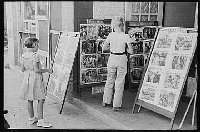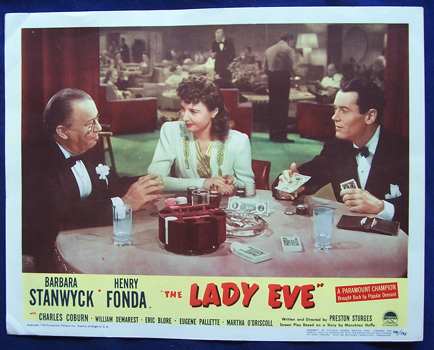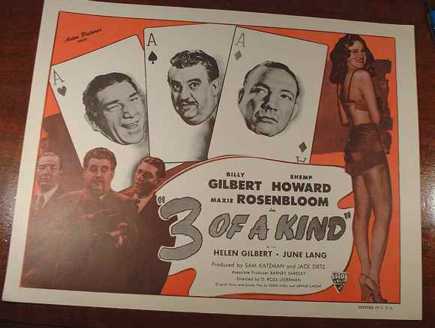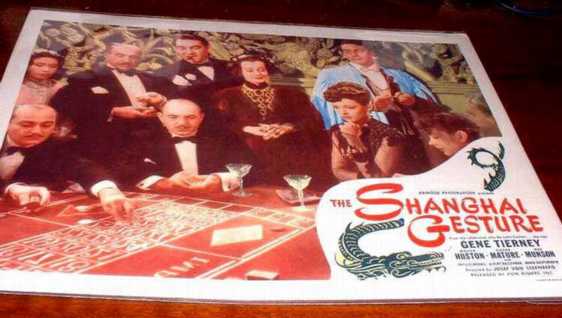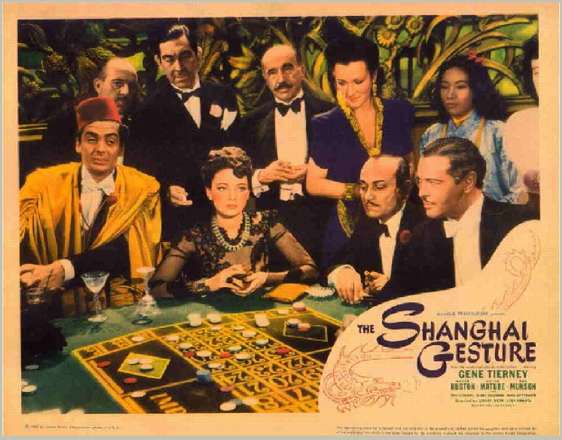From about the 1920's
to the 1960's practically all the films produced in the U.S.
had lobby cards to advertise them. In the 1970's and 80's,
the studios slowly quit making them for U.S. distribution. Today
they are mainly used abroad. In their heyday, lobby cards were
usually issued in sets of eight, 11"x 14," on a fairly heavy stock of
paper. Full color LC's began about 1925 (note also that many black&white
films had colorized lobby cards). Most of the studios used the
National Screen Service Corp. to distribute the cards and films to
the theaters. Each film would be given a NSS number (ID code).
In the "Port of Wickedness" LC, above, the number (usually in
the lower right corner) is R54\255. "R" means re-release (the films
was originally released as "Barbary Coast" in 1935), "54" is the year of
re-release, and "255" means this was the 255th movie released or re-released
in 1954...... ....... ....Lobby cards were displayed in the theaters,
either on a board (as shown above) or scattered throughout the theater
lobby in separate framed windows. The above picture is taken from
this fine site which contains much movie lobby card, poster, etc. information
-- LearnAboutMoviePosters.com
...... ........ ......... As with gambling chips, most lobby cards
are worthless or worth a dollar or two, and others are worth
thousands of dollars!
From FilmPosters.com: �Lobby Cards are no longer used in U.S. theaters
and are rarely produced for today's films. These small movie posters
(usually 11"x14" in a landscape, or horizontal format, printed on card
stock) were generally produced in sets of eight, although the number of
cards in a set can vary from as few as four to as many as 16. �. As the
name suggests, these small movie posters were designed for display in a
theater's lobby or foyer with the intention of luring patrons into the
theater by showing glimpses of key scenes from the movie. A lobby card
set typically consists of one Title Card (TC), a lobby card of special
design usually depicting all key stars, listing credits and designed to
represent the entire film rather than a single scene, and seven Scene
Cards (SC), each depicting a different scene from the movie. .. �. Lobby
Cards made their first appearance in the early 1910s around the same
time that Charlie Chaplin was breaking into motion pictures. The
earliest Silent-era lobby cards were often nothing more than black and
white or duotone stills. These were eventually replaced by hand-tinted
scenes, and by the 1920s most studios were producing full-color lobby
cards. � �The collectibility value of lobby cards is influenced by
several factors, the most important of which is the graphic appeal of
the card itself. A lobby card featuring a closeup of the main actors, or
the monster, or depicting a key scene, is much more desirable than a
card showing only a distant shot of the stars, or a "dead" card
featuring no stars at all. The importance or popularity of the film is
another key factor in determining a lobby card's value.�
|

